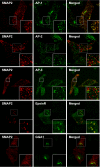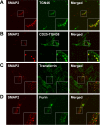SMAP2, a novel ARF GTPase-activating protein, interacts with clathrin and clathrin assembly protein and functions on the AP-1-positive early endosome/trans-Golgi network
- PMID: 16571680
- PMCID: PMC1475504
- DOI: 10.1091/mbc.e05-10-0909
SMAP2, a novel ARF GTPase-activating protein, interacts with clathrin and clathrin assembly protein and functions on the AP-1-positive early endosome/trans-Golgi network
Abstract
We recently reported that SMAP1, a GTPase-activating protein (GAP) for Arf6, directly interacts with clathrin and regulates the clathrin-dependent endocytosis of transferrin receptors from the plasma membrane. Here, we identified a SMAP1 homologue that we named SMAP2. Like SMAP1, SMAP2 exhibits GAP activity and interacts with clathrin heavy chain (CHC). Furthermore, we show that SMAP2 interacts with the clathrin assembly protein CALM. Unlike SMAP1, however, SMAP2 appears to be a regulator of Arf1 in vivo, because cells transfected with a GAP-negative SMAP2 mutant were resistant to brefeldin A. SMAP2 colocalized with the adaptor proteins for clathrin AP-1 and EpsinR on the early endosomes/trans-Golgi-network (TGN). Moreover, overexpression of SMAP2 delayed the accumulation of TGN38/46 molecule on the TGN. This suggests that SMAP2 functions in the retrograde, early endosome-to-TGN pathway in a clathrin- and AP-1-dependent manner. Thus, the SMAP gene family constitutes an important ArfGAP subfamily, with each SMAP member exerting both common and distinct functions in vesicle trafficking.
Figures









Similar articles
-
Transport of the cholera toxin B-subunit from recycling endosomes to the Golgi requires clathrin and AP-1.J Cell Sci. 2015 Aug 15;128(16):3131-42. doi: 10.1242/jcs.172171. Epub 2015 Jul 1. J Cell Sci. 2015. PMID: 26136365
-
A SMAP gene family encoding ARF GTPase-activating proteins and its implication in membrane trafficking.Methods Enzymol. 2008;438:155-70. doi: 10.1016/S0076-6879(07)38011-7. Methods Enzymol. 2008. PMID: 18413247
-
Localization of SMAP2 to the TGN and its function in the regulation of TGN protein transport.Cell Struct Funct. 2011;36(1):83-95. doi: 10.1247/csf.10022. Epub 2011 Feb 26. Cell Struct Funct. 2011. PMID: 21368446
-
New directions for the clathrin adaptor AP-1 in cell biology and human disease.Curr Opin Cell Biol. 2022 Jun;76:102079. doi: 10.1016/j.ceb.2022.102079. Epub 2022 Apr 13. Curr Opin Cell Biol. 2022. PMID: 35429729 Free PMC article. Review.
-
Emerging roles of Golgi/endosome-localizing monomeric clathrin adaptors GGAs.Anat Sci Int. 2020 Jan;95(1):12-21. doi: 10.1007/s12565-019-00505-2. Epub 2019 Oct 28. Anat Sci Int. 2020. PMID: 31659673 Review.
Cited by
-
Involvement of a novel ADP-ribosylation factor GTPase-activating protein, SMAP, in membrane trafficking: implications in cancer cell biology.Cancer Sci. 2006 Sep;97(9):801-6. doi: 10.1111/j.1349-7006.2006.00251.x. Epub 2006 Jun 29. Cancer Sci. 2006. PMID: 16805823 Free PMC article. Review.
-
The Arf GAP SMAP2 is necessary for organized vesicle budding from the trans-Golgi network and subsequent acrosome formation in spermiogenesis.Mol Biol Cell. 2013 Sep;24(17):2633-44. doi: 10.1091/mbc.E13-05-0234. Epub 2013 Jul 17. Mol Biol Cell. 2013. PMID: 23864717 Free PMC article.
-
S655 phosphorylation enhances APP secretory traffic.Mol Cell Biochem. 2009 Aug;328(1-2):145-54. doi: 10.1007/s11010-009-0084-7. Epub 2009 Apr 21. Mol Cell Biochem. 2009. PMID: 19381782
-
BioTarget: A Computational Framework Identifying Cancer Type Specific Transcriptional Targets of Immune Response Pathways.Sci Rep. 2019 Jun 21;9(1):9029. doi: 10.1038/s41598-019-45304-x. Sci Rep. 2019. PMID: 31227749 Free PMC article.
-
Transcriptome meta-analysis of Kawasaki disease in humans and mice.Front Pediatr. 2024 Sep 16;12:1423958. doi: 10.3389/fped.2024.1423958. eCollection 2024. Front Pediatr. 2024. PMID: 39350793 Free PMC article.
References
-
- Aoe T., Huber I., Vasudevan C., Watkins S. C., Romero G., Cassel D., Hsu V. W. The KDEL receptor regulates a GTPase-activating protein for ADP-ribosylation factor 1 by interacting with its non-catalytic domain. J. Biol. Chem. 1999;274:20545–20549. - PubMed
-
- Bernards A. GAPs galore! A survey of putative Ras superfamily GTPase activating proteins in man and Drosophila. Biochim. Biophys. Acta. 2003;1603:47–82. - PubMed
-
- Chiba N., Watanabe T., Nomura S., Tanaka Y., Minowa M., Niki M., Kanamaru R., Satake M. Differentiation dependent expression and distinct subcellular localization of the protooncogene product, PEBP2beta/CBFbeta, in muscle development. Oncogene. 1997;14:2543–2552. - PubMed
-
- Cremona O. Live stripping of clathrin-coated vesicles. Dev. Cell. 2001;1:592–594. - PubMed
Publication types
MeSH terms
Substances
LinkOut - more resources
Full Text Sources
Other Literature Sources
Molecular Biology Databases
Miscellaneous

